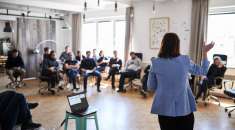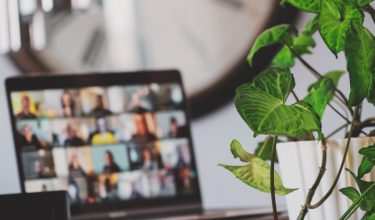
#leadership #strategy #transformation

29. Nov. 2021 |
- min Lesezeit
Of course, workshops and strategy meetings can be organized digitally without any problems, and creative output and results are not impaired. But what’s missing is the relaxed atmosphere, spontaneous fun, and, quite honestly, a gin and tonic now and then after a day spent together.
So, how should we organize our work in the future? What do our teams want? How often do they want to go to the office? And how do we design office space to best suit their new needs?
We addressed these questions in one of our improvement sessions, which we carry out regularly to challenge existing processes and structures and adapt to new circumstances. Continuous learning, collaborative working and thinking, and a high level of transparency are building blocks of our corporate culture - and that brings us to an important point:
“
The culture of your company is now your place of work.
“
Accoring to Leandro Herrero’s article on Linkedin, the known organizational framework needs to adapt fundamentally. The author believes that corporate culture is now more important than ever as the glue for cohesion. We think that’s true.
For our team of more than 50 people, digital working was normal even before Corona - thus, the home office was, and is, and will remain important to us. But we honestly don’t yet know in detail what the post-corona hybrid model will look like. The fact that this significant topic is currently challenging companies around the world is a very exciting thought, and we are looking forward to working together to further develop our corporate culture to meet the new needs—even though this means new investments and renewed changes.
There are all kinds of studies, ranging from “not back to the office at all” to “back to only working in the office”. The result of our internal employee survey was that our teams would like it to be “totally flexible”. However, from an organization’s perspective, there are severe challenges. The all-important questions are: how do we replace or build elements that create togetherness? And how will we work hybrid with each other in the years to come?
The commute needs to be recalculated. With some of us travelling up to an hour, many of us now need a good reason to come to the office.
So why the office?
But the advantages of a home office should not be underestimated:
Onboarding is very important to us, and we have smooth processes in place for that. But newer colleagues, who joined us in times of corona, don’t yet have a fixed desk in the office and are now encountering a new environment in which some claims have already been staked. Of course, those who have been on board for a while are looking for their previous places or have even deposited their personal belongings on the desk to be able to work better and more creatively. Some of us have also taken monitors home. We need a solution to this issue. Whether the solution will be a desk sharing tool or whether we introduce a model like Flaconi with “travelers” (three days home office) or “settlers” (fixed place in the office) is still up in the air.
Experience from companies around the world shows that employees in home offices are not as visible and may even lose career opportunities. If those who have care responsibilities at home or don’t like to come into the office more often for other reasons, such as distance from the workplace, are unknowingly disadvantaged, something is going wrong. We must keep the issue of diversity in mind here. But should we impose rigid requirements for this reason and introduce a duty for office days? That doesn’t fit in with our culture. And what about those who want to work from another city? From a recruiting perspective, this question is becoming increasingly urgent. So far, we’ve managed this balancing act very well - not only through virtual collaboration, but also via our Friday routine, virtual coffee dates and secure face-to-face off-site meetings with the entire team, such as hiking on the Isar river.
For us, hybrid work is a model that we want to develop sustainably—in other words, it is much more than just working at home for a few days. Digital tools are already an integral part of all our projects. Workshops with customers now work virtually without any problems, and long business trips are hardly necessary. The important thing for us now is to bring the digital together with the analogue, and to get the best out of New Work, even better. However, this requires smart and new structures, which we can - and must - design now. When should a team come to the office? How are decisions made when part of the team works in the office and another part is on the road?
If we dissolve the previous seating structure in favour of “hot desks” or desk sharing, this will change the culture. The advantage is, for example, being able to collaborate closely and spontaneously with others, depending on the occasion, provided the equipment is right and all the monitors, etc., are there. But do we really require mirrored office space for everyone at home? Can devices also be used abroad for security reasons? Does it even affect our salary when we set up our home office, as Google is doing? What we already know, is that it doesn’t make sense for employees to come into the office only to make virtual calls alone in a meeting room so that others aren’t disturbed. However, we expect much more from “deep work areas” or movable walls that create new structures as needed. We are now even better at being flexible.
Virtual work has become the norm in recent months. Therefore, our focus now is on shaping our culture without the daily face-to-face interactions. Whether analogue or digital, at our core, trust and respect are paramount, and we want to keep it that way. The pandemic experience makes us realize how important it is to always assume the best in collaboration first, and to trust each other to get the job done. Whether this happens at five in the morning or eleven in the evening, is usually irrelevant. Flexibility and appreciation are also significant values. We have noticed that we can rely on each other, even with virtual and asynchronous communication. Looking at the experience so far, we believe that companies that offer their employees such a flexible and trusting environment will continue to benefit from it long after the immediate impact of COVID-19 has ended, with the potential to attract and retain the most talented employees.
